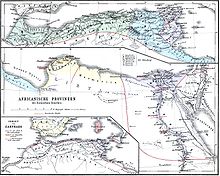Simminensis (diocese)

Simminensis is an ancient and titular episcopal see of the Roman province of Africa Proconsularis in modern Tunisia, and a suffragan diocese of the Archdiocese of Carthage.[1][2][3][4]
Etymology[edit]
Simminensis, also known as Siminina, Siminensis, or Simminensis, means "to sow".
History[edit]
Semina is today a titular diocese in the Proconsolare of Carthage.[5][6] and a number of titular bishops have sat in 20th century. Founded in the Roman era only one bishop is known for certain from antiquity, St. Fiorenzo, who participated in the Council of Carthage (484) convened by the Vandal king Huneric, after which he was exiled to Corsica . Two other ancient bishops from the city are also inferred from literary sources. The first Deuterium Simminensis is mentioned in the Notitia Africae of 484AD, while the second Iunianus or Martin[7] took part in the Council of Carthage (525).
The bishopric is mentioned by Anonymous of Ravenna.[8]
Known bishops[edit]
- Rudolf Pierskała (Titular bishop: 7 Dec 2013 – )
- Ján Orosch (Titular bishop: 2 Apr 2004 to 11 Jul 2013)
- Timothy Anthony McDonnell (Titular bishop: 30 Oct 2001 to 9 Mar 2004)
- Thomas Khamphan † (Titular bishop: 10 Jul 1975 to 26 Jul 2001)
- Pierluigi Sartorelli † (Titular archbishop: 9 Nov 1967 to 7 Oct 1972)
- Bishop Florients[9]
- The Notitia Africae[10] also names one Deuterius from Simminensis [11] However, it is uncertain if he was Bishop of Simminensis or if he was from the town and bishop elsewhere.
- Another, Plebis, or Martin of Siminensis took part in the Council of Carthage (525).
Location[edit]
The exact location of Simminensis is unknown. It would appear to have been somewhere on the north-western coast of Cap Bon 30 km east of Carthage. It is held by some to be at Mraissa.[12] Babelon, however, suspected its location at Dagla, Tunisia.[13] While Tissot in turn suspected the ancient city to the south, at Henchir Bir Djedi.[14]
References[edit]
- ^ Stefano Antonio Morcelli, Africa Christiana, Volume I (Brescia 1816).
- ^ Francois Morenas, Dictionnaire historique-portatif de la geographie sacree ancienne et moderne (etc.) (Desaint et Saillant, 1759)page 673.
- ^ Louis de Mas Latrie, Migne, Dictionary of Religious Statistics and art of verifying dates (JP Migne, 1831) p701.
- ^ Portable Historical Dictionary of formerly sacred geography. (Francis Morenas, 1759) p673.
- ^ Semina at CatholicHierarchy.org.
- ^ Semina at GCatholic.org.
- ^ A. Rose Les diocèses en Afrique (2009).
- ^ p447.
- ^ Giovan Domenico Mansi, Philippe Labbe, Jean Baptiste Martin, Gabriel Cossart, Louis Petit, E. Baluze, Sacrorum conciliorum nova et amplissima collectio, cujus Johannes Dominicus Mansi et post ipsius mortem Florentius et Venetianus editores ab anno 1758 ad annum 1798 priores triginta unum tomos ediderunt, nunc autem continuatat et absoluta, Volume 31, Part 1 (expensis H. Welter, 1906) p1158.
- ^ Notitia Africae of the year 484.
- ^ Theodore Ruinart, The history of the persecution of the Vandals, into two distinct parts. The first comprises the five books of Victor, Bishop of Vita (Robustel, 1699).
- ^ Arachne - Topography 8007461
- ^ E. Babelon - R. Cagnat - S. Reinach, Atlas Archéologique de la Tunisie. Atlas archéologique de la Tunisie: édition spéciale des cartes topographiques publiées par le Ministère de la Guerre. accompagnée d'un texte explicatif Redige par Mm (Paris 1893);
- ^ Ch Tissot, Exploration scientifique de la Tunisie: Geography comparée de la province d'Afrique romaine (Paris 1884–1888)
